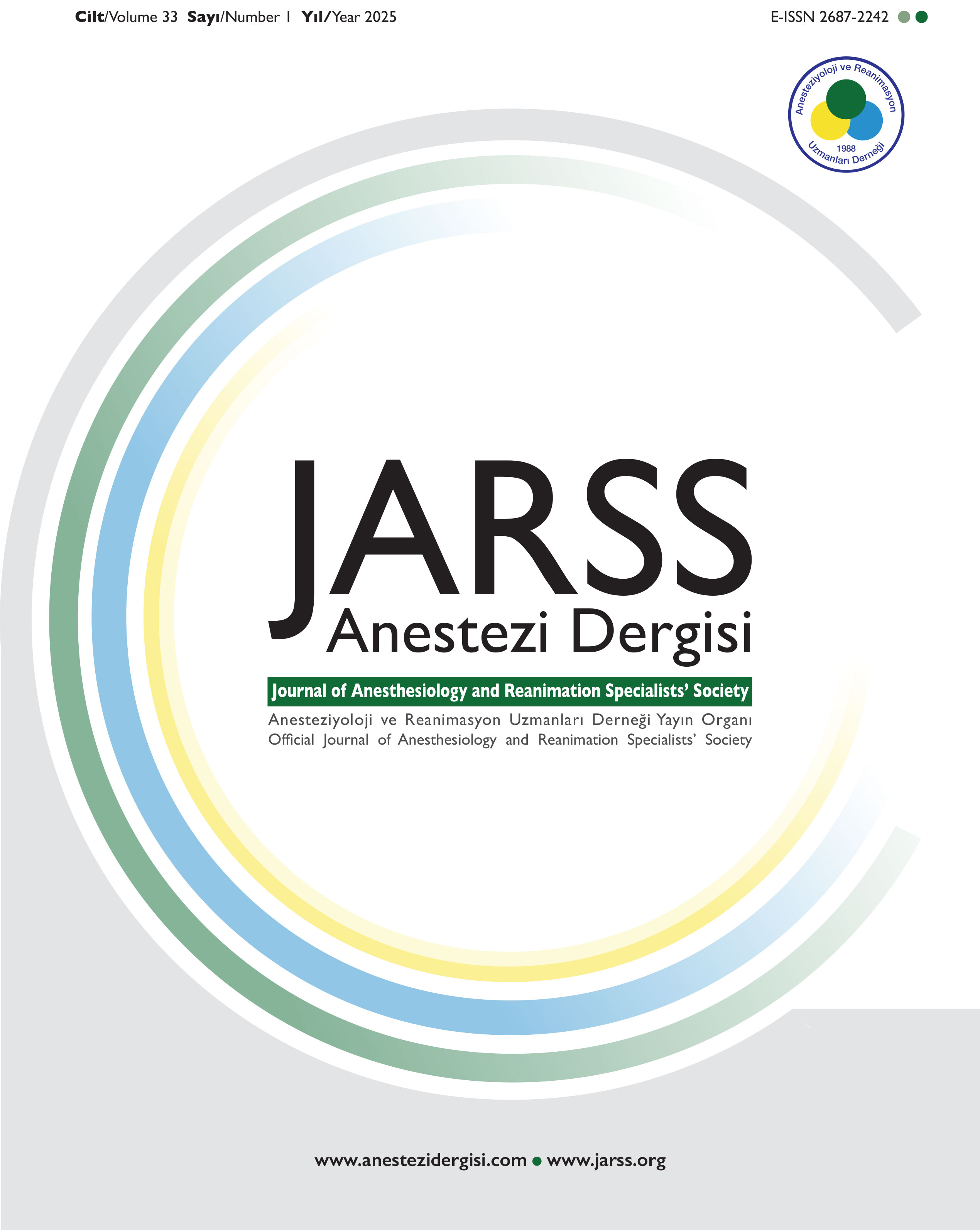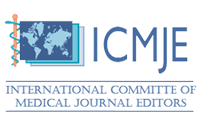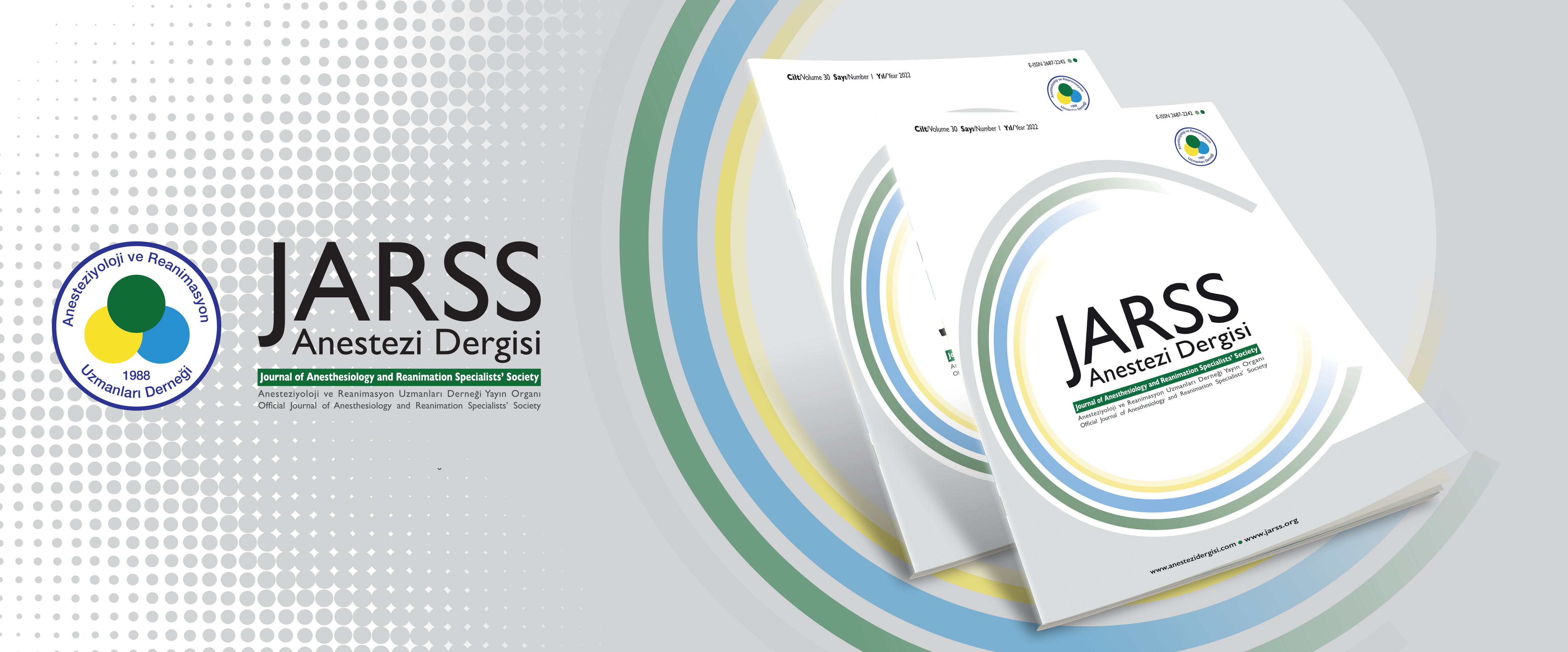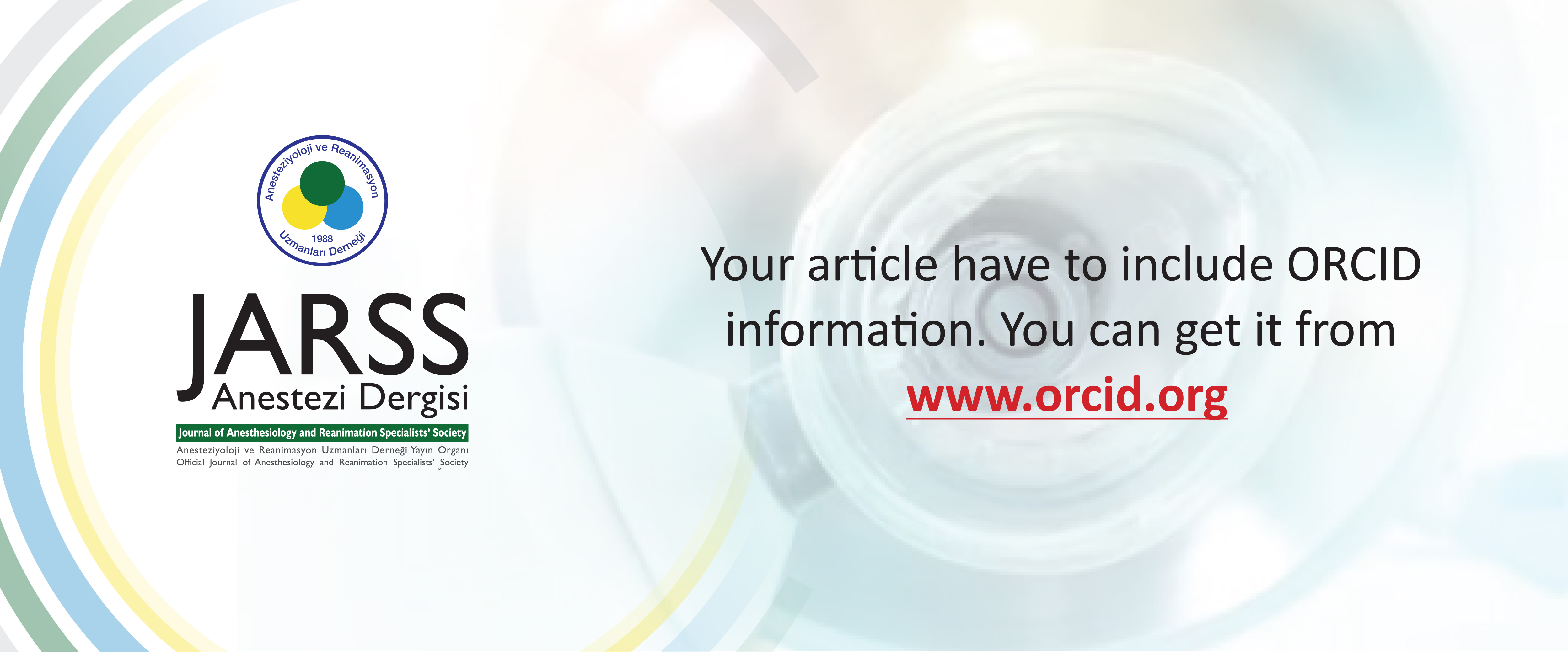Volume: 30 Issue: 1 - 2022
| 1. | Cover Page I (569 accesses) |
| 2. | Advisory Board Pages II - V (626 accesses) |
| 3. | Editorial Page VI (418 accesses) |
| 4. | Contents Pages VII - VIII (388 accesses) |
| ORIGINAL RESEARCH | |
| 5. | A Comparative Study on the Analgesic Efficacy of Bilateral Suprazygomatic Maxillary Nerve Block Under Ultrasound Guidance with 0.25% Bupivacaine and 0.25% Bupivacaine with Dexmedetomidine in Paediatric Patients Undergoing Cleft Palate Repair - A Randomize Arul Murugan Ramasamy, Senthil Kumar Sukumar, Prabavathi Srinivasan, Venkata Rajesh Kumar Kodali, Akilandeswari Manickam, Aruna Parameswari, Mahesh Vakamudi doi: 10.54875/jarss.2022.36744 Pages 1 - 8 (583 accesses) Objective: Cleft palate repair involves surgery on the both hard and soft palate leading to severe pain, intense sympathetic stimulation, and bleeding. In our study we analysed the analgesic efficacy of bupivacaine alone and bupivacaine with dexmedetomidine in ultrasound guided bilateral suprazygomatic maxillary nerve block (SMN) for cleft palate repair. Methods: This study was a randomized prospective doubleblinded study. Fourty six children of the ASA class I and II posted for cleft palate repair were randomized into Group A and Group B. In Group A, 23 children had SMN block with 0.15 mL kg-1 of 0.25% bupivacaine with saline and the same procedure was repeated on other side. In Group B, 23 children received SMN block with a volume of 0.15 mL kg-1 of 0.25% bupivacaine with dexmedetomidine 0.5 μg kg-1 on each side. Primary outcomes analysed were pain scores in post operative period by Children and Infants Post-Operative Pain Scale (CHIPPS) and the analgesia duration. Postoperative pain scores were analysed at 30 minutes intervals for 2 hours in Post Anaesthesia Care Unit (PACU) and at every 2 hours interval for 24 hours in the postoperative ward. Results: Group A and B were comparable in demographic variables like age, gender, weight, ASA status, and duration of surgery. Children in Group B had significantly longer duration of analgesia when compared to that of Group A (12±4.73 hours vs 5.41± 3.9 hours) (p=0.003). Children had significantly lower pain scores in Group B at zero min in PACU (p=0.04), after 90 min (p=0.02), at 2 hours (p<0.001), 4 hours (p<0.001), 6 hours (p=0.006) and at 8 hours (p=0.02) when compared to that in Group A. Conclusion: Children who received bupivacaine with dexmedetomidine in SMN block had a longer analgesia duration and lesser postoperative pain scores than children who received bupivacaine alone. |
| 6. | Use of ProSeal Laringeal Mask Airway Under Bronchoscopy Guidance During Percutaneous Dilatational Tracheostomy Eylem Yaşar, Ezgi Dönmez, Semra Gumus Demi&775;rbi&775;lek doi: 10.54875/jarss.2022.77598 Pages 9 - 15 (510 accesses) Objective: In the current study, our primary aim is to compare complication rates between using ProSeal laryngeal mask airway (P-LMA) and endotracheal tube (ETT) in bronchoscopy-guided percutaneous dilatational tracheostomy (PDT) procedure. Our secondary aim is to compare the processing time of these two techniques. Methods: Sixty-one adult patients who were intubated in the intensive care unit and scheduled for PDT due to the need for long-term mechanical ventilation were included in the study. The patients were randomly divided into ETT group or P-LMA group under bronchoscopy guidance. Complications related to the procedures and the duration of each procedure were recorded. Hemodynamic measurements, oxygen saturation, arterial blood gas analysis, preferred mechanical ventilation mode, positive end expiratory pressure and mean airway pressure values were recorded before PDT, and 30 minutes after the procedure. Results: A total of 61 cases, 23 (38%) female and 38 (62%) male, participated in the study. Regarding the complication rates between the groups, we encountered more complications in the ETT group and the most common complication was puncture of the cuff of the intubation tube. The procedure time was also significantly shorter in the P-LMA group (P-LMA; 2.5 min, ETT; 3.6 min). Conclusion: Using P-LMA for PDT under bronchoscopy caused lower complication rate than using ETT. In a addition the duration of PDT procedure was shorter in P-LMA group than ETT group. |
| 7. | Investigation of the Attitude and Perceptions of Anesthesiologist and General Practitioners on Referring Patients to Palliative Care Centers: A Survey Study Gülten Ütebey doi: 10.54875/jarss.2022.37167 Pages 16 - 21 (1042 accesses) Objective: Physicians’ approaches are important in refering patients to palliative care centers (PCC). We aimed to evaluate the perceptions and attitudes of general practitioners and anesthesiologist on patient referral. Methods: Anesthesiologist and general practitioners were included in a face to face or telephone interview method survey; predefined written forms were used to collect data and results were analyzed. Results: The research was completed with 207 participants. Groups were different regarding their knowledge about PC, most of the general practitioners responded “I know a litle” and anesthesiologists responded “I know what it is, I can explain it to someone else” (p=0.002). The answers to the question of which patients should be referred to PCC (“End-stage cancer patients” [p=0.018], “Patients referred home care services” [p=0.003] and “Patients having chronic ilness without adequate symptom control” [p=0.004], “Patients having total parenteral nutrition” [p=0.001], “Precence of pressure ulcer” [p<0.001], “Patients refusing discharge” [p=0.037] ) were different between anesthesiologists and general practitioners. Conclusion: Anesthesiologists and general practitioners refer patients with different diagnoses and conditions to PCC and knowledge about patient referral to PC is different. |
| 8. | Retrospective Evaluation of the Effectiveness of Superior Hypogastric Plexus Block in Chronic Pelvic Pain Dostali Aliyev, Ümit Akkemik, İbrahim Aşık doi: 10.54875/jarss.2022.52824 Pages 22 - 27 (598 accesses) Objective: Chronic pain is a cause that negatively affects the quality of life and functional capacity. As with most chronic pain syndromes, chronic pelvic pain requires a multimodal approach. Hypogastric plexus blockade and neurolysis may be effective in cases that do not respond to conservative treatments. In this study, we retrospectively evaluated the effect of hypogastric plexus blockade in patients with chronic pelvic pain. Methods: Forty patients with chronic pelvic pain (duration of pain> 6 months) who underwent hypogastric plexus block under fluoroscopy were evaluated retrospectively. Neurolysis was performed after diagnostic block in 19 patients with chronic pelvic pain associated with pelvic cancer. Results: While the visual analogue scale (VAS) of the patients who underwent superior hypogastric block was 8.8 before the procedure, the VAS scores at 1 month, 3 months and 6 months after the procedure were recorded as 3.7, 2.2, and 1.1, respectively (p<0.05). While the mean Oswestry Disabilty Index (ODI) score of the patients before the procedure was 46.0% (severe disability), it was recorded as 3% at the 6th month. The changes in VAS and ODI scores were statistically significant (p<0.05). Conclusion: Hypogastric plexus blockade should be considered as an effective treatment option in the treatment of chronic pelvic pain. |
| 9. | Evaluation of Worry and Anxiety in the Postpandemic Normalization Process in Operating Room Staff Esra Doğan, Munire Babayiğit, Esra Özayar doi: 10.54875/jarss.2022.32559 Pages 28 - 35 (908 accesses) Objective: The COVID-19 pandemic, which is a rapidly spreading infection, has caused serious stress and anxiety in people, primarily healthcare workers. In our study, we aimed to determine the anxiety of loss of professional skills that may be caused by staying away from operations for a long time due to the pandemic in operating room workers and the reasons that may cause anxiety caused by working under the threat of coronavirus infection during the normalization process. Methods: The population of this cross-sectional study consists of doctors, nurses, technicians, and auxiliary personnel working in the operating room of our hospital. Sociodemographic form, health histories, Worry and Anxiety Questionaire (WAQ) and occupational skill loss anxiety questionnaire were applied to the researchers. Results: Worry and Anxiety (WA) scores and occupational anxiety scores of female healthcare workers were found to be statistically significantly higher than males. It was determined that the WA scores of the anesthesia assistants and operating room nurses were statistically significantly higher than the scores of the surgeons and assistants. It was determined that the WA scores of the participants with chronic disease were statistically significantly higher than those without chronic disease. Conclusion: Psychological support should be continued for health workers who work under intense working conditions and high risk, especially for health workers on the front line, and their family members when necessary. It has been determined that anesthetists and health workers who have previously had psychological disorders and chronic diseases carry a high risk of worry and anxiety, and psychological support should be prioritized. |
| 10. | Evaluation of Intravascular Volume Status by Pleth Variability Index in Transurethral Prostate Resections Behiç Girgin, Umut Kara, Mehmet Burak Eskin, Engin Kaya, Ahmet Coşar doi: 10.54875/jarss.2022.27676 Pages 36 - 41 (895 accesses) Objective: Patients with benign prostatic hypertrophy (BPH) are treated with transurethral resection of the prostate (TURP). The passage of irrigation fluid into the systemic circulation can cause hypervolemia, hyponatremia and due to them TURP syndrome with restlessness, confusion, dyspnea, arrhythmia and seizures. The most important point is early diagnosis. Our aim was to reveal the statistical relationship between serum sodium (Na) values and the pleth variability index (PVI) in patients who underwent TURP. Methods: Thirty-three ASA I-III and 40-80 years old patients who underwent TURP under spinal anesthesia were included in the study. The patients were taken to the operating room and standard monitoring was applied. Venous blood samples were taken from the peripheral vascular access before and after the procedure, and Na values were determined; PVI values were recorded at 5-minute intervals from the preoperative period to the postoperative period by performing PVI monitoring. Results: The PVI data correlated with postoperative osmolarity, postoperative Na concentration, resection time and irrigation amount as an early predictor of hypervolemia and seconder hyponatremia. Conclusion: We think that more comprehensive case studies are needed in terms of the usability of PVI, which is a noninvasive method compared to blood gas sampling, an invasive method for the diagnosis of hypervolemia and hyponatremia, and that continuous monitoring and follow-up provide an advantage in early diagnosis. |
| 11. | Intravenous Port Catheter Implantation: Retrospective Study in Single Center Experience Mete Manici, Kamil Darçın, Agah Isguzar, Sami Kaan Coşarcan, Barış Küçükerdem, Ömür Erçelen doi: 10.54875/jarss.2022.18894 Pages 42 - 47 (555 accesses) Objective: Totally implantable venous access ports (TIVAPs) are widely preferred for oncology patients who need chemotherapy. Although peripheral cannula or catheter in a large vein may help chemotherapy treatment; some complications such as vascular irritation, thrombosis may interrupt the treatment. To avoid this interruption, TIVAPs are usually preferred. The aim of the study was to evaluate device related complications and safety with anesthesia team implanted TIVAPs. Methods: This retrospective study was conducted on patients who underwent procedure for implantation of TIVAPs in our hospital between the dates of January 2017 - December 2020. The demographic data, vascular access side, complications seen related to TIVAPs insertion procedure, the number of removed catheters, reasons of removal of catheters were recorded. Results: During this study period 700 TIVAPs procedure have been performed in our clinic. While 646 patients (92.3%) had right sided TIVAPs, 678 patients (96.8%) had TIVAPs inserted to subclavian vein. When the most common cancer seen in this patient group was colorectal cancer, hepatobiliary tract cancer group came second. Total number of removed catheters for some reasons was 107 which is 15.2% of all patients. When the causes for catheter removal were examined, it was discovered that although systemic infection was the most common reason (47 patients, or 6.7%), the number of patients with positive culture from the port was extremely rare (19 patients) (2.71%). Conclusion: We think that when TIVAPs are inserted under ultrasound guidance and fluoroscopy control in the operating room, the incidence of complications will be relatively low. Especially in cancer patients, TIVAPs can be inserted and used safely with high patient comfort. |
| 12. | Truncal Cutaneous Temperature Changes and Anthropometry in Spinal Anaesthesia - An Observational Study Sree Kumar E J, Janani Ramachandran, Gautham Ganesan, Arul Murugan Ramasamy doi: 10.54875/jarss.2022.24865 Pages 48 - 54 (529 accesses) Objective: The predictability of onset of sympathetic block in spinal anaesthesia is poor. The role of the structures around the dural sac, in determining the spread of local anaesthetic in the subarachnoid space, is evaluated by studying the effect of the peri-spinal frustum volume on the change in cutaneous temperature and perception of cold sensation. Methods: In patients planned for spinal anaesthesia with 2.5 mL of 0.5% heavy bupivacaine intrathecally, volume of frustum between T8 and L3 was calculated using abdominal circumference at T8 and L3 and the distance between these spinous processes. The speed of onset at T8 level was measured as a change of 0.5 °C in cutaneous temperature probe and loss of cold sensation. Results: Of the 40 patients analysed, 22 patients had increase in cutaneous temperature while 14 had a decrease and 4 had no change. The onset time of loss of cold sensation in seconds was 327.68±169.65 (99% CI: 234.51–420.85) and 232.64±75.47 (99% CI 180.69-284.60) in patients with increase and decrease of the skin probe respectively. The square of correlation coefficient (R2) of frustum volume was 0.55 (99% CI -0.15-0.88, p=<0.01) in the group with decrease in skin temperature and 0.03 (99% CI -0.51- 0.55, p=0.46) in group with increase in skin temperature. Conclusion: The effect of peri-spinal volume on the speed of onset of block at T8 level is variable and somatic block correlates only in patients who had a decrease in skin temperature. |
| 13. | Anesthesia Management and Use of Ultrasonography in Patients Undergoing Whole Lung Lavage Under General Anesthesia: A Retrospective Analysis Volkan Şıvgın, Aycan Özdemirkan, Yusuf Ünal, Nurdan Köktürk doi: 10.54875/jarss.2022.98250 Pages 55 - 61 (724 accesses) Objective: Whole lung lavage (WLL) is a treatment procedure for pulmonary alveolar proteinosis (PAP), in which lung is washed with large amounts of saline in a controlled manner. Our aim is to analyze the anesthesia management and the ultrasonography use during WLL, retrospectively. Methods: Preoperative and perioperative anesthesia related data and data on the use of ultrasonography of 19 WLL precedures of 11 patients, with PAP, performed between January 2018 and December 2020 were evaluated. Results: A statistically significant difference was found in the partial oxygen pressure and peripheral oxygen saturation values of the patients after WLL when compared to the pre-procedure (p<0.001). The number of patients who required O2 decresaed to 1 from 9 after WLL (p=0.008) Complications were recorded in only 4 of 19 procedures. While only hypoxia was observed during one procedure, hypoxemia and fluid leakage were detected during two procedures. Hypoxemia, fluid leakage and hypotension were detected in one procedure. Conclusion: Whole lung lavage procedure is safe when performed by an experienced and coordinated team in management of PAP patients. We think that ultrasonography may play an effective role in continuing the procedure safely and in early diagnosis of complications that may occur during WLL. |
| 14. | Experiences of Anesthesiology and Reanimation Specialists in the COVID-19 Pandemic: A Focus Group Study Pınar Ayvat doi: 10.54875/jarss.2022.60362 Pages 62 - 70 (630 accesses) Objective: To reveal the opinions and experiences of anesthesiologists, who are actively working during the pandemic that emerged in 2020 and continue, regarding the problems, changes, needs, and solution suggestions regarding the COVID-19 process. Methods: The research was conducted with the qualitative research method. A focus group meeting was held with 6 anesthesiologists who agreed to participate in the study. Thematic content analysis was performed on the data via MAXQDA 20. Results: As a result of the research, 4 main themes and 11 subthemes were reached. These main themes are experienced problems and changes, needs, contributions to the field of Anesthesiology and Reanimation, and suggestions. Anesthesiologists said that they were adversely affected by the COVID-19 process, working conditions changed, they had problems in the management of emergencies and in the supply of equipment for a long time, and that these problems increased their anxiety and fear with the uncertainty of the COVID-19 disease. When their needs in the COVID-19 process are evaluated, they need the fair distribution of assignments in the health sector, the well-equipped personnel, the improvement of physical conditions, and the elimination of their economic concerns. In addition to the problems experienced, when the contributions of the COVID-19 process were evaluated, anesthesiologists declared that they used the equipment more efficiently and conducted more research by developing treatment techniques. Conclusion: It was determined that the experienced COVID-19 process forced the anesthesiologists, the probability of contracting the COVID-19 disease was high due to their active work, they suffered the loss of rights in the process. It was concluded that it is important to protect the physiological, economic, and psychological conditions of the anesthesiologists and to meet their needs. |
| LETTER TO THE EDITOR | |
| 15. | Surgical and Anesthetic Management of Postpartum Hemorrhage Forty-Five Days After Cesarean Section M. Funda Cevher Akdulum, Nuray Camgöz Eryılmaz, Dudu Berrin Günaydın, Ayse Borkluce, Esra Isci Bostanci, Ahmet Erdem doi: 10.54875/jarss.2022.38358 Pages 71 - 73 (402 accesses) Abstract | |

















